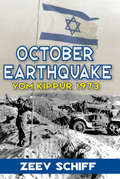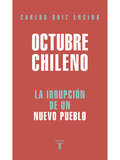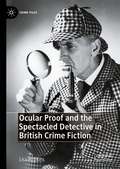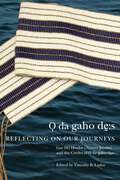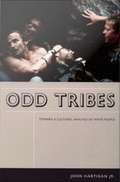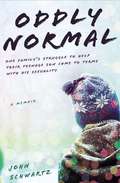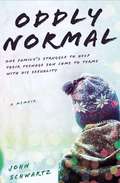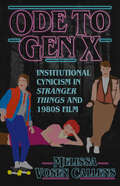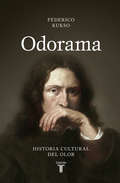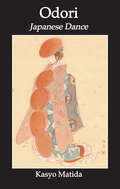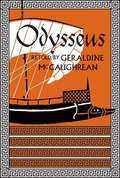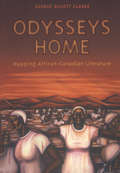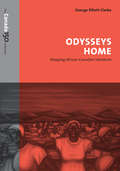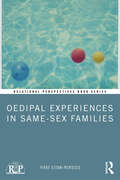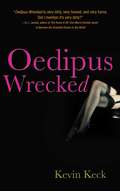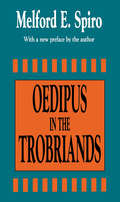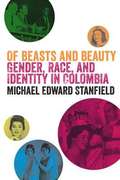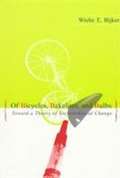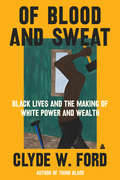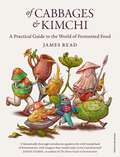- Table View
- List View
October Earthquake: Yom Kippur 1973
by Yehoshafat HarkabiOctober Earthquake presents a chronological account of the days surrounding the Day of Atonement (Yom Kippur) War, along with the significant military and political events of each day of the conflict. Zeev Schiff's comments on Israel's exaggerated self-confidence, the hopelessness of Israeli leadership, the intelligence failure, the concept of the Bar Lev Line, the role of the air force, and the preparedness of the Arab army are interspersed throughout.Rather than judging and awarding "grades" to the parties involved in the war, this work bases itself on authentic source materials, such as recordings of command discussions during the battles, and documents. Many of the details included are not found elsewhere. The author skillfully weaves the recollections and accounts of many participants and commentators into a coherent narrative that brings to life the war's events.Although written largely from the perspective of Israelis, October Earthquake reviews political, diplomatic, and military events in Egypt that set the stage for the war. In the postscript, Schiff also explores key lessons for Israel from the Yom Kippur War, which ended its sense of invincibility and complacency, despite Israel's impressive victories on the battlefield. Winner of the Sokolov Prize, Israel's highest journalism award, this book should be read by all foreign policy specialists, historians, and anyone interested in the Middle East.
Octubre chileno: La irrupción de un nuevo pueblo
by Carlos Ruiz EncinaUn breve ensayo del destacado sociólogo chileno en el que se analizan los acontecimientos de octubre y el porvenir de la sociedad chilena. «No lo vimos venir», afirmaron muchas personas luego del 18 de octubre. Para Carlos Ruiz, esta declaración no es sino una reacción de la élite, que miró con estupor todo lo que vino durante los días posteriores a la revuelta social. Sin embargo, el estallido no solo fue la furia. Trajo consigo algo mayor, asegura el sociólogo y autor de este libro: el surgimiento de un nuevo pueblo.
Ocular Proof and the Spectacled Detective in British Crime Fiction (Crime Files)
by Lisa HopkinsFrom Sherlock Holmes onwards, fictional detectives use lenses: Ocular Proof and the Spectacled Detective in British Crime Fiction argues that these visual aids are metaphors for ways of seeing, and that they help us to understand not only individual detectives’ methods but also the kinds of cultural work detective fiction may do. It is sometimes regarded as a socially conservative form, and certainly the enduring popularity of ‘Golden Age’ writers such as Christie, Sayers, Allingham and Marsh implies a strong element of nostalgia in the appeal of the genre. The emphasis on visual aids, however, suggests that solving crime is not a simple matter of uncovering truth but a complex, sophisticated and inherently subjective process, and thus challenges any sense of comforting certainties. Moreover, the value of eye-witness testimony is often troubled in detective fiction by use of the phrase ‘the ocular proof’, whose origin in Shakespeare’s Othello reminds us that Othello is manipulated by Iago into misinterpreting what he sees. The act of seeing thus comes to seem ideological and provisional, and Lisa Hopkins argues that the kind of visual aid selected by each detective is an index of his particular propensities and biases.
Odagahodhes: Reflecting on Our Journeys (McGill-Queen's Indigenous and Northern Studies)
by Gae Ho Jacobs The Circles of OdagahodhesIn the words of Cayuga Elder Gae Ho Hwako Norma Jacobs: “We have forgotten about that sacred meeting space between the Settler ship and the Indigenous canoe, odagahodhes, where we originally agreed on the Two Row, and where today we need to return to talk about the impacts of its violation.”Odagahodhes highlights the Indigenous values that brought us to the sacred meeting place in the original treaties of Turtle Island, particularly the Two Row Wampum, and the sharing process that was meant to foster good relations from the beginning of the colonial era. The book follows a series of Indigenous sharing circles, relaying teachings by Gae Ho Hwako and the responses of participants – scholars, authors, and community activists – who bring their diverse experiences and knowledge into reflective relation with the teachings. Through this practice, the book itself resembles a teaching circle and illustrates the important ways tradition and culture are passed down by Elders and Knowledge Keepers. The aim of this process is to bring clarity to the challenges of truth and reconciliation. Each circle ends by inviting the reader into this sacred space of Odagahodhes to reflect on personal experiences, stories, knowledge, gifts, and responsibilities.By renewing our place in the network of spiritual obligations of these lands, Odagahodhes invites transformations in how we live to enrich our communities, nations, planet, and future generations.
Odd Tribes: Toward a Cultural Analysis of White People
by John Hartigan Jr.Odd Tribes challenges theories of whiteness and critical race studies by examining the tangles of privilege, debasement, power, and stigma that constitute white identity. Considering the relation of phantasmatic cultural forms such as the racial stereotype "white trash" to the actual social conditions of poor whites, John Hartigan Jr. generates new insights into the ways that race, class, and gender are fundamentally interconnected. By tracing the historical interplay of stereotypes, popular cultural representations, and the social sciences' objectifications of poverty, Hartigan demonstrates how constructions of whiteness continually depend on the vigilant maintenance of class and gender decorums. Odd Tribes engages debates in history, anthropology, sociology, and cultural studies over how race matters. Hartigan tracks the spread of "white trash" from an epithet used only in the South prior to the Civil War to one invoked throughout the country by the early twentieth century. He also recounts how the cultural figure of "white trash" influenced academic and popular writings on the urban poor from the 1880s through the 1990s. Hartigan's critical reading of the historical uses of degrading images of poor whites to ratify lines of color in this country culminates in an analysis of how contemporary performers such as Eminem and Roseanne Barr challenge stereotypical representations of "white trash" by claiming the identity as their own. Odd Tribes presents a compelling vision of what cultural studies can be when diverse research methodologies and conceptual frameworks are brought to bear on pressing social issues.
Oddly Normal: One Family's Struggle to Help Their Teenage Son Come to Terms with His Sexuality
by John SchwartzA heartfelt memoir by the father of a gay teen, and an eye-opening story for families who hope to bring up well-adjusted gay adults. Three years ago, John Schwartz, a national correspondent atThe New York Times, got the call that every parent hopes never to receive: his thirteen-year-old son, Joe, was in the hospital following a failed suicide attempt. After mustering the courage to come out to his classmates, Joe's disclosure -- delivered in a tirade about homophobic attitudes--was greeted with dismay and confusion by his fellow students. Hours later, he took an overdose of pills. Additionally, John and his wife, Jeanne, found that their son's school was unable to address Joe's special needs. Angry and frustrated, they initiated their own search for services and groups that could help Joe understand that he wasn't alone. Oddly Normal is Schwartz's very personal attempt to address his family's own struggles within a culture that is changing fast, but not fast enough to help gay kids like Joe. Schwartz follows Joseph through childhood to the present day, interweaving his narrative with common questions, including: Are effeminate boys and tomboy girls necessarily gay? Is there a relationship between being gay and suicide or mental illness? Should a child be pushed into coming out? Parents, teachers, and counselors alike will welcome Oddly Normal and its crucial lessons about helping gay kids -and any kid who is different -- learn how to cope in a potentially hostile world.
Oddly Normal: One Family's Struggle to Help Their Teenage Son Come to Terms with His Sexuality
by John SchwartzThree years ago, John Schwartz, a national correspondent for The New York Times, got the call that every parent hopes never to receive: His thirteen-year-old son, Joe, was in the hospital following a suicide attempt. Mustering the courage to come out to his classmates, Joe had delivered a tirade about homophobic and sexist attitudes that was greeted with unease and confusion by his fellow students. Hours later, he took an overdose of pills. After a couple of weeks in the hospital and in the locked ward of a psychiatric treatment center, Joe returned to his family. As he recovered, his parents were dismayed by his school's inability to address -- or reluctance to deal with -- Joe's needs. Determined to help their son feel more comfortable in his own skin, Schwartz and his wife, Jeanne, launched their own search for services and groups that could help Joe know he wasn't alone. In Oddly Normal, Schwartz writes of his family's struggles within a culture that is changing fast - but not fast enough. Interweaving his narrative with contextual chapters on psychology, law, and common questions, Schwartz shares crucial lessons about helping gay kids learn how to cope in a potentially hostile world. From buying rhinestone-studded toddler shoes to creating a "Joseph manual" for Joe's teachers; from finding a hairdresser who stocks purple dye to fighting erroneous personality disorder diagnoses, Oddly Normal offers a deeply personal look into one boy's growing up. Joe, far happier today than he was three years ago, collaborated on this work.
Ode to Gen X: Institutional Cynicism in Stranger Things and 1980s Film
by Melissa Vosen CallensEven for the casual viewer, the Netflix series Stranger Things will likely feel familiar, reminiscent of popular 1980s coming-of-age movies such as The Goonies, E.T. the Extra-Terrestrial, and Stand by Me. Throughout the series, nods to each movie are abundant. While Stranger Things and these classic 1980s films are all tales of childhood friendship and shared adventures, they are also narratives that reflect and shape the burgeoning cynicism of the 1980s. In Ode to Gen X: Institutional Cynicism in "Stranger Things" and 1980s Film, author Melissa Vosen Callens explores the parallels between iconic films featuring children and teenagers and the first three seasons of Stranger Things, a series about a group of young friends set in 1980s Indiana. The text moves beyond the (at times) non-sequitur 1980s Easter eggs to a common underlying narrative: Generation X’s growing distrust in American institutions. Despite Gen X’s cynicism toward both informal and formal institutions, viewers also see a more positive characteristic of Gen X in these films and series: Gen X’s fierce independence and ability to rebuild and redefine the family unit despite continued economic hardships. Vosen Callens demonstrates how Stranger Things draws on popular 1980s popular culture to pay tribute to Gen X’s evolving outlook on three key and interwoven American institutions: family, economy, and government.
Odin: Ecstasy, Runes, & Norse Magic
by Diana L. Paxson“Paxson provides songs, rituals, magical exercises, and practical advice to help you develop your own personal relationship with the Lord of Runes.” —Judika Illes, author of Encyclopedia of 5,000 SpellsOdin is arguably one of the most enigmatic and complex characters in Norse mythology. Revered since the Viking Age, Odin has been called the greatest of the gods—the god of words and wisdom, runes and magic, a transformer of consciousness, and a trickster who teaches truth. He is both war god and poetry god, and he is the Lord of Ravens, the All- Father, and the rune master.Odin: Ecstasy, Runes, and Norse Magic is the first book on Odin that is both historically sourced and accessible to a general audience. It explores Odin’s origins, his appearances in sagas, old magic spells, and the Poetic Edda, and his influence on modern media, such as Tolkien’s Lord of the Rings trilogy. Each chapter features suggestions for rituals, exercises, and music, so readers can comprehend and become closer to this complicated god.Author Diana Paxson, an expert on Viking-era mythology, provides a complete portrait of Odin and draws on both scholarship and experience to provide context, resources, and guidance for those who are drawn to work with the Master of Ecstasy today.“This remarkable book is at times ribald and reverent, worldwise and innocent, pragmatic and idealistic, as needed to masterfully show the ways of a very complex God.” —Ivo Domiguez, Jr, author of Keys to Perception
Odorama: Historia cultural del olor
by Federico KuksoPorque vivir es respirar y respirar es necesariamente oler, la primera historia cultural del olor. Un compendio de historias asombrosas y desconocidas que conectan el ayer, el hoy y el mañana de la humanidad a través de la dimensión olfativa de nuestra vida. *¿Cómo olían los dinosaurios? *¿Qué aromas gobernaban en el antiguo Egipto? *¿Cuánto apestaban París, Londres, Nueva York, Buenos Aires en el pasado? *¿Qué olieron los astronautas que caminaron sobre la Luna? *¿A qué huelen una estrella, una galaxia, un agujero negro? Aromas, perfumes, fragancias, hedores inciden en cómo nos sentimos y en qué pensamos. Omnipresentes, los olores son máquinas del tiempo y el espacio capaces de transportarnos a distintos momentos y lugares de nuestras vidas. Sin embargo, son esquivos: no existen suficientes palabras en nuestro vocabulario para describir cabalmente lo que olemos ni dispositivo capaz de capturar la huella olfativa de una época. Acallados muchas veces, desvalorizados casi siempre, los olores dejan rastros donde pueden: de crónicas a registros médicos o culinarios, de jeroglíficos a epistolarios románticos. El pasado del planeta y de cada uno de nosotros está inscripto en la memoria de sus olores. Si vivir es respirar y respirar es necesariamente oler, Odorama es un compendio de historias asombrosas que conectan el ayer, el hoy y el mañana a través de la dimensión olfativa de nuestra vida.
Odori: Japanese Dance
by MatidaFirst published in 2005. Routledge is an imprint of Taylor & Francis, an informa company.
Oduduwa's Chain: Locations of Culture in the Yoruba-Atlantic
by Andrew ApterYoruba culture has been a part of the Americas for centuries, brought from Africa during the transatlantic slave trade and maintained in various forms ever since. In Oduduwa’s Chain, Andrew Apter explores a wide range of fascinating historical and ethnographic examples and offers a provocative rethinking of African heritage in Black Atlantic Studies. Focusing on Yoruba history and culture in Nigeria, Apter applies a generative model of cultural revision that allows him to identify formative Yoruba influences without resorting to the idea that culture and tradition are fixed. For example, Apter shows how the association of African gods with Catholic saints can be seen as a strategy of empowerment, explores historical locations of Yoruba gender ideologies and their variations in the Atlantic world, and much more. He concludes with a rousing call for a return to Africa in studies of the Black Atlantic, resurrecting a critical notion of culture that allows us to transcend Western inventions of African while taking them into account.
Odysseus
by Geraldine MccaughreanOne of the legends in world mythology comes to life in this retelling of the adventures of Odysseus after the fall of Troy. Cunning and wise, Odysseus is the son and successor of King Laertes of Ithaca, and led the Greek army during the Trojan War.
Odysseys Home: Mapping African-Canadian Literature
by George Elliott ClarkeOdysseys Home: Mapping African-Canadian Literature is a pioneering study of African-Canadian literary creativity, laying the groundwork for future scholarly work in the field. Based on extensive excavations of archives and texts, this challenging passage through twelve essays presents a history of the literature and examines its debt to, and synthesis with, oral cultures. George Elliott Clarke identifies African-Canadian literature's distinguishing characteristics, argues for its relevance to both African Diasporic Black and Canadian Studies, and critiques several of its key creators and texts. Scholarly and sophisticated, the survey cites and interprets the works of several major African-Canadian writers, including André Alexis, Dionne Brand, Austin Clarke, Claire Harris, and M. Nourbese Philip. In so doing, Clarke demonstrates that African-Canadian writers and critics explore the tensions that exist between notions of universalism and black nationalism, liberalism and conservatism. These tensions are revealed in the literature in what Clarke argues to be - paradoxically - uniquely Canadian and proudly apart from a mainstream national identity. Clarke has unearthed vital but previously unconsidered authors, and charted the relationship between African-Canadian literature and that of Africa, African America, and the Caribbean. In addition to the essays, Clarke has assembled a seminal and expansive bibliography of texts - literature and criticism - from both English and French Canada. This important resource will inevitably challenge and change future academic consideration of African-Canadian literature and its place in the international literary map of the African Diaspora.
Odysseys Home: Mapping African-Canadian Literature
by George Elliott ClarkeOdysseys Home: Mapping African-Canadian Literature is a pioneering study of African-Canadian literary creativity, laying the groundwork for future scholarly work in the field. Based on extensive excavations of archives and texts, this challenging passage through twelve essays presents a history of the literature and examines its debt to, and synthesis with, oral cultures. George Elliott Clarke identifies African-Canadian literature's distinguishing characteristics, argues for its relevance to both African Diasporic Black and Canadian Studies, and critiques several of its key creators and texts. Scholarly and sophisticated, the survey cites and interprets the works of several major African-Canadian writers, including André Alexis, Dionne Brand, Austin Clarke, Claire Harris, and M. Nourbese Philip. In so doing, Clarke demonstrates that African-Canadian writers and critics explore the tensions that exist between notions of universalism and black nationalism, liberalism and conservatism. These tensions are revealed in the literature in what Clarke argues to be – paradoxically – uniquely Canadian and proudly apart from a mainstream national identity. Clarke has unearthed vital but previously unconsidered authors, and charted the relationship between African-Canadian literature and that of Africa, African America, and the Caribbean. In addition to the essays, Clarke has assembled a seminal and expansive bibliography of texts – literature and criticism – from both English and French Canada. This important resource will inevitably challenge and change future academic consideration of African-Canadian literature and its place in the international literary map of the African Diaspora.
Oedipal Experiences in Same-Sex Families (ISSN)
by Yifat Eitan-PersicoThis book updates the Oedipus complex for a contemporary audience in the light of social and cultural changes and explores its implications for psychoanalytic treatment and our understanding of queer families.Growing evidence during the past few decades indicates that children who grow up in same-sex families adapt well. These findings, which do not conform to the predictions of Oedipal theory, expose the theory’s biases, and call for reexamination of its premises. This book based on ground-breaking research and pursues a methodical investigation of the characteristics of the same-sex families that defy the expectations of Oedipal theory. Furnished with vivid illustrations, it invites the reader to engage actively in the interpretive effort and presents a diverse and complex story about kinship, opening a window onto a rich world of infantile phantasies and parents’ psychological conflicts, at the fascinating intersection of the personal and the social.Oedipal Experiences in Same-Sex Families will appeal to psychoanalysts, psychotherapists, educators and policymakers, same-sex parents, and parents who were assisted by gamete donation.
Oedipus Rex in the Genomic Era: Human Behaviour, Law and Society
by Yulia Kovas Fatos SelitaThis book explores the answers to fundamental questions about the human mind and human behaviour with the help of two ancient texts. The first is Oedipus Rex (Oedipus Tyrannus) by Sophocles, written in the 5th century BCE. The second is human DNA, with its origins around 4 billion years ago, and continuously revised by chance and evolution. With Sophocles as a guide, the authors take a journey into the Genomic era, an age marked by ever-expanding insights into the human genome. Over the course of this journey, the book explores themes of free will, fate, and chance; prediction, misinterpretation, and the burden that comes with knowledge of the future; self-fulfilling and self-defeating prophecies; the forces that contribute to similarities and differences among people; roots and lineage; and the judgement of oneself and others.Using Oedipus Rex as its lens, this novel work provides an engaging overview of behavioural genetics that demonstrates its relevance across the humanities and the social and life sciences. It will appeal in particular to students and scholars of genetics, education, psychology, sociology, and law.
Oedipus Wrecked
by Kevin KeckIf David Sedaris were straight (or Margaret Cho were a man), they might be Kevin Keck. Keck mines the same rich vein of candid, confessional humor as these popular comics, but Oedipus Wrecked goes further in single-mindedly, hilariously recounting every grim detail of the author's almost absurdly varied sexual history. Keck pulls no punches in describing his endless, obsessive erotic experiments. In essays like "Ass Backwards," "Wet, Hot Presbyterian Summer," and "I Was a Teenage Homosexual," Keck skewers his eccentric mother (whose dildo he swipes), documents his plunge into the "chorus of coming" on a sex party line, and limns a particularly outré encounter with a girl who demands he participate in water sports but won't "have sex" because "that's a sin." For a driven horndog like Keck, sexual taboos exist to be broken. Still he always pays a price through numbing guilt or fear of discovery -- though neither prevents him from embarking on the next quest for love and orgasms. Keck's tableaux of sexual excess are rendered in vivid, unflinching language that marks the emergence of a new voice in contemporary humor that's both cuttingly comic and startlingly revelatory.
Oedipus in the Trobriands
by Melford E. SpiroSpiro challenges the argument of Bronislaw Malinowski that the matrilineal society of the Trobriand Islands produced a psychological constellation -- a matrilineal complex -- different from Freud's Oedipus complex and the generalization regarding the restrictive provenance of the Oepidus complex to which it gave rise. Spiro undertakes a reanalysis of Malinowski's data and shows that there is enough to suggest the presence of a strong Oedipus complex.Melford E. Spiro is professor emeritus of anthropology at the University of California, San Diego, where he founded the Anthropology Department in 1968. His other works include Gender and Culture, Oedipus in the Trobriands, and Culture and Human Nature.
Of Ants and Men
by David G. GreenWhy do things go wrong? Why, despite all the planning and care in the world, do things go from bad to worse? This book argues that it is because we are like the ants. Just as ants create an anthill without being aware of it, unintended side effects of human activity create all manner of social trends and crises. The book traces the way these trends emerge and the role they play in some of the major issues of our time. One of the greatest challenges today is the complexity of our social and economic systems. Every action has side effects that people often ignore or fail to see. The book examines the ways in which limitations in our thinking and behaviour lead to unintended side effects. It looks at the role played by complex networks of interactions. Finally, it looks at the way side effects of new technologies, especially computers and communication, have created an Information Revolution, the full repercussions of which are yet to be seen. In our race to create new technologies and sustain indefinite economic growth, we are at best dimly aware of the ways in which we are transforming society and threatening our environment.
Of Beards and Men: The Revealing History of Facial Hair
by Christopher Oldstone-MooreBeards—they’re all the rage these days. Take a look around: from hip urbanites to rustic outdoorsmen, well-groomed metrosexuals to post-season hockey players, facial hair is everywhere. The New York Times traces this hairy trend to Big Apple hipsters circa 2005 and reports that today some New Yorkers pay thousands of dollars for facial hair transplants to disguise patchy, juvenile beards. And in 2014, blogger Nicki Daniels excoriated bearded hipsters for turning a symbol of manliness and power into a flimsy fashion statement. The beard, she said, has turned into the padded bra of masculinity.Of Beards and Men makes the case that today’s bearded renaissance is part of a centuries-long cycle in which facial hairstyles have varied in response to changing ideals of masculinity. Christopher Oldstone-Moore explains that the clean-shaven face has been the default style throughout Western history—see Alexander the Great’s beardless face, for example, as the Greek heroic ideal. But the primacy of razors has been challenged over the years by four great bearded movements, beginning with Hadrian in the second century and stretching to today’s bristled resurgence. The clean-shaven face today, Oldstone-Moore says, has come to signify a virtuous and sociable man, whereas the beard marks someone as self-reliant and unconventional. History, then, has established specific meanings for facial hair, which both inspire and constrain a man’s choices in how he presents himself to the world. This fascinating and erudite history of facial hair cracks the masculine hair code, shedding light on the choices men make as they shape the hair on their faces. Oldstone-Moore adeptly lays to rest common misperceptions about beards and vividly illustrates the connection between grooming, identity, culture, and masculinity. To a surprising degree, we find, the history of men is written on their faces.
Of Beasts and Beauty: Gender, Race, and Identity in Colombia
by Michael Edward StanfieldAll societies around the world and through time value beauty highly. Tracing the evolutions of the Colombian standards of beauty since 1845, Michael Edward Stanfield explores their significance to and symbiotic relationship with violence and inequality in the country. Arguing that beauty holds not only social power but also economic and political power, he positions it as a pacific and inclusive influence in a country “ripped apart by violence, private armies, seizures of land, and abuse of governmental authority, one hoping that female beauty could save it from the ravages of the male beast. ” One specific means of obscuring those harsh realities is the beauty pageant, of which Colombia has over 300 per year. Stanfield investigates the ways in which these pageants reveal the effects of European modernity and notions of ethnicity on Colombian women, and how beauty for Colombians has become an external representation of order and morality that can counter the pathological effects of violence, inequality, and exclusion in their country.
Of Bicycles, Bakelites, and Bulbs: Toward a Theory of Sociotechnical Change
by Wiebe E. BijkerThis book integrates detailed case studies with theoretical generalizations and political analyses to offer a fully rounded treatment both of the relations between technology and society and of the issues involved in sociotechnical change.
Of Blood and Sweat: Black Lives and the Making of White Power and Wealth
by Clyde W. Ford“Ford’s overlap of past and present, narrative and commentary is masterful, and makes this volume all the more valuable to those readers wise enough to allow the past to inform the future. Of Blood and Sweat is a myth-busting work of genius that will stand as the last word on this vital subject for a long time to come.”—Elizabeth Dowling Taylor, New York Times bestselling author of A Slave in the White House and The Original Black EliteIn this, provocative, timely, and painstakingly researched book, the award-winning author of Think Black tells the story of how Black labor helped to create and sustain the wealth of the white one percent throughout American history.Clyde W. Ford uses the lives of individual Black men and women as a lens to explore the role they have played in creating American institutions of power and wealth—in agriculture, politics, jurisprudence, law enforcement, culture, medicine, financial services, and many other fields—while not being allowed to fully participate or share in the rewards. Today, activists have taken the struggle for racial equity and justice to the streets. Of Blood and Sweat goes back through time to excavate the roots of this struggle, from pre-colonial Africa through post-Civil War America. As Ford reveals, in tracing the history of almost any major American institution of power and wealth you’ll find it was created by Black Americans, or created to control them.Painstakingly researched and documented, Of Blood and Sweat is a compelling look at the past that holds broad implications for present-day calls for racial equity, racial justice, and the abolishment of systemic racism, and offers invaluable insight into our understanding of Black history and the story of America.
Of Cabbages and Kimchi: A Practical Guide to the World of Fermented Food
by James ReadA playful and accessible guide to fermenting at homeJames Read is on a mission to smuggle bacteria into our kitchens. In Of Cabbages & Kimchi, he takes the ten greatest 'living' ferments - fermented foods that are neither cooked nor pasteurized - and places them under the microscope, before cooking with them in all their delicious versatility. From the fiery funk of kimchi to the velvet tang of kefir, James describes the microbial process, then shares his recipes for recreating these wonders in your own kitchen - no specialist equipment required. Alongside his recipes, James investigates the extraordinary cultural and historic backgrounds of fermented foods, exploring how the microbes that bring them to life have developed alongside our culinary evolution. Featuring over fifty recipes - including Mushroom and Sauerkraut Pierogi, Chilled Radish Noodle Soup and Green Chilli Fermented Salsa - and packed to the brim with Marija Tiurina's gastro-surrealist watercolour illustrations, Of Cabbages and Kimchi will help you create, understand and appreciate fermentation's bubbling magic.
